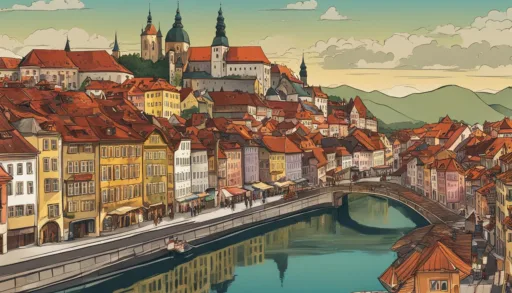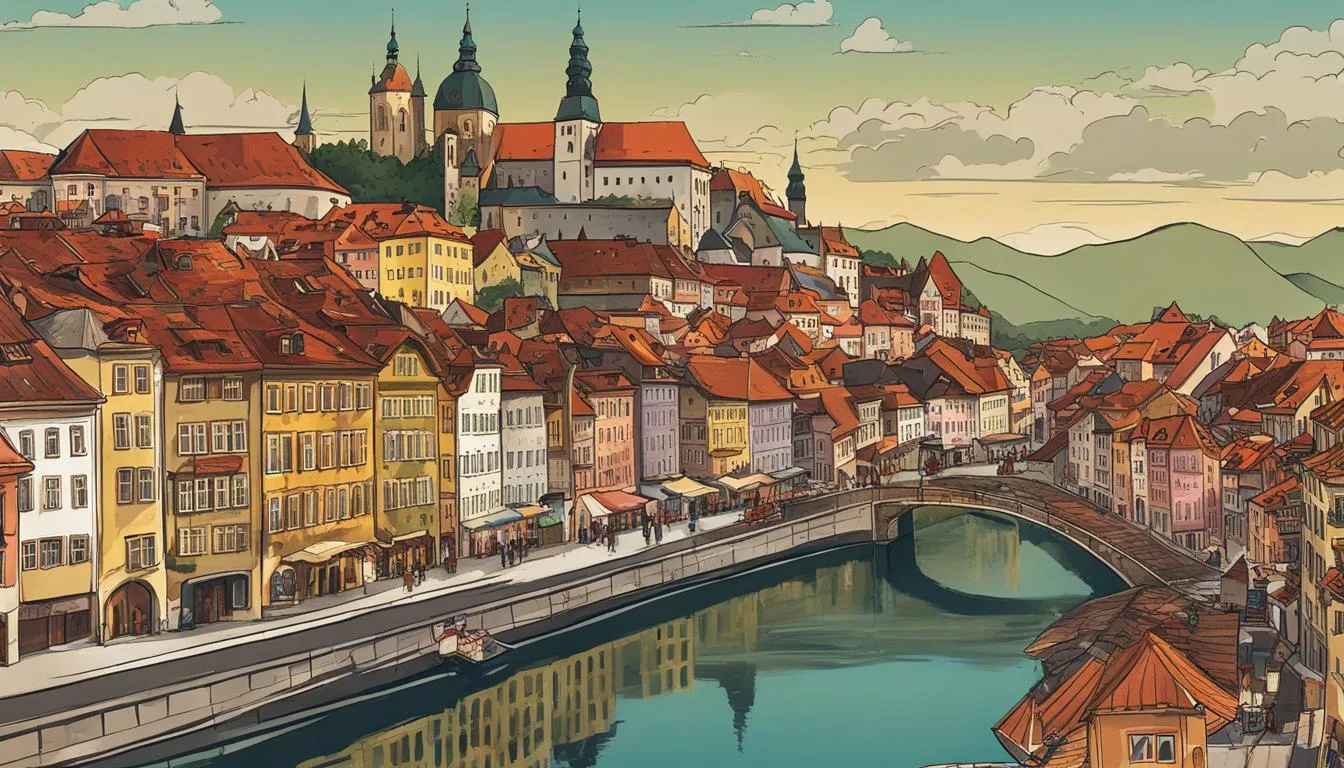Did you know that Slovenia ranks impressively high among European countries for its foreign language proficiency, with a swirl of different tongues spoken across its scenic landscapes? This fusion of languages spoken in Slovenia is a testament to the country’s rich cultural tapestry. At the heart of this linguistic diversity Slovenia cherishes, the Slovenian language (Slovene) stands as the official language, alongside a creative ensemble of other languages that mark the country’s inclusive spirit. Reflecting its history as a confluence of various cultures, Slovenia recognizes not only Slovene but also Italian and Hungarian as official languages in some municipalities, highlighting the respect for its linguistic heritage and diversity. While Slovene dominates the communication streams, Italy’s and Hungary’s neighboring influences contribute to the linguistic diversity Slovenia proudly fosters.
Key Takeaways
- Slovenian language remains the dominant and official language of Slovenia, echoing in every aspect of life.
- Italy and Hungary impart a significant linguistic influence leading to their languages enjoying co-official status in certain areas.
- The constitutional protection of minority languages in Slovenia underscores the nation’s commitment to diversity.
- Immigration and international exchange have introduced Croatian, Serbian, and other languages to Slovenia’s linguistic landscape.
- English, German, and additional foreign languages are widely spoken due to Slovenia’s emphasis on language learning and proficiency.
- Slovenian Sign Language is recognized, ensuring communication inclusiveness for the deaf community.
Linguistic Landscape of Slovenia
The language landscape Slovenia offers is as varied as its scenic topography. From the Julian Alps to the rolling hills of the Pannonian Plain, the country’s linguistic profile is a living testament to its historical crossroads. Reflecting centuries of migration, trade, and conquest, Slovenia’s current language tapestry weaves together a striking pattern of diversity and cultural richness.
Historical Confluence of Languages
Slovenia’s history paints a vivid picture of linguistic intermingling. The Slavic, Germanic, Romance, and Uralic tongues have all etched their influence into the nation’s cultural canvas. These interactions have created a multilingual environment that is both complex and unique within Europe, with historical roots that delve deep into the past, merging traditions and shaping the dialects in Slovenia.
Modern-day Demographics and Language Usage
Recent demographic trends outline the linguistic diversity Slovenia embraces today. While Slovene reigns as the lingua franca, the presence of Italian and Hungarian minority languages is constitutionally safeguarded, acknowledging their historic communities. This balance of linguistic variety is further enriched by other South Slavic languages, setting Slovenia apart as a beacon of multicultural dialogue in Central Europe. Languages such as Croatian, Serbian, and Serbo-Croatian—brought forth by the complex tides of the region’s history—have taken their place alongside the national tongue, contributing to the fascinating mosaic of voices that make up modern-day Slovenia.
Languages Spoken Slovenia: Diversity and Official Status
In the rich cultural tapestry of Slovenia, the languages spoken reflect a harmonious blend of historical influences and contemporary shifts. At the heart of this linguistic diversity is the Slovene language, which stands as the cornerstone of the nation’s communication, serving as one of the official languages Slovenia is known for. A significant majority of the Slovenian population converse in this Slavic tongue, which is also the bedrock of national education and government.
However, Slovenia’s commitment to linguistic variety extends beyond its borders to include minority languages in Slovenia. Notably, Italian and Hungarian enjoy co-official status in regions densely populated by these ethnic groups. Here, legislation ensures that these languages hold a respectable position, with bilingual signage and official documents including these languages to accommodate local populations.
The linguistic landscape of Slovenia is further enriched by immigrant languages that have become more prominent over the recent decades. While not holding official status, languages such as Croatian, Serbian, and Romani are integral to the daily lives of many communities and are indicative of the evolving demographic profile of the country.
- Slovene: The Primary Language
- Italian: Co-official in areas adjoining Italy
- Hungarian: Co-official in areas adjoining Hungary
- Immigrant Languages: Including but not limited to Croatian, Serbian, and Romani
With the presence of such linguistic diversity, Slovenia stands as a model of cultural integration, balancing the necessity of a unified official language with the respect and recognition of its minority and immigrant tongues.
The Slovenian Language: An Overview
The Slovenian language, also known as Slovene, is more than just a means of communication in Slovenia; it embodies the nation’s essence and is a cornerstone of its cultural identity. Having gained prominence as the official language, Slovene marks its presence in every aspect of the country’s official affairs, education system, and media outlets.
Constitutional Status and Education
In Slovenia, Slovene is not only widely spoken but is also legislatively protected, ensuring that the language thrives in academic and official settings. It’s a symbol of national pride, featured on currency and sung in the national anthem. From the bustling cities to the picturesque countryside, language instruction in Slovenia is rooted in promoting Slovene from the earliest years of schooling, subsequently continuing up to the highest levels of education.
Slovene proficiency is deemed crucial for those seeking to immerse themselves fully in the Slovenian educational system. Even non-native speakers are encouraged to develop fluency, especially if they aim to pursue undergraduate programs in the country. Nonetheless, the international influx and global exchanges have opened avenues for instruction in English, particularly at graduate levels, catering to international scholars.
Presence in Media and Public Life
The Slovenian language takes center stage in media and public communications, resonating through TV broadcasts, radio stations, and print media. By law, businesses are required to integrate Slovene into their operations, be it in branding, advertising, or customer service. Yet, a commitment to inclusivity is evident through available translations for important materials in other languages, reflecting Slovenia’s respect for linguistic diversity within a unified national framework.
Moreover, technological advances and digital media proliferation have not hindered but rather enhanced the presence of Slovene language in the public sphere. Slovenia’s active engagement in harnessing new platforms ensures the language’s vitality and its accessibility to both residents and visitors alike.
Learning and utilizing Slovene is a uniquely enriching experience, and language instruction in Slovenia not only empowers individuals to engage with the local culture but also bridges communication in this centrally positioned European nation. Teachers, students, and professionals alike acknowledge the significance of the Slovenian language in fostering connections, celebrating heritage, and embracing future opportunities.
Recognized Minority Languages in Slovenia
While the Slovenian language takes center stage as the national language, the rich tapestry of Slovenia’s cultural heritage is also woven with the threads of its minority languages. Italian and Hungarian communities, in particular, are supported by a framework that ensures their linguistic traditions are not just maintained but celebrated.
Italian and Hungarian: Recognized and Protected
In the realms adjacent to Italy and Hungary, there’s a palpable presence of minority languages that have been granted co-official status. The Italian language in Slovenia enjoys widespread use and is bolstered by an array of bilingual services designed to cater to the Italian-speaking community. Here, bilingual signage, media broadcasts, and educational resources provide a nurturing environment for the Italian language to flourish.
Similarly, the Hungarian language in Slovenia is upheld with equal enthusiasm. Hungarian-speaking Slovenians experience a well-supported linguistic environment, chiefly in settlements dotted along the Hungarian border. Schools providing primary to secondary education in Hungarian, dedicated media, and government services ensure the continuity and growth of this cherished language.
Other Notable Minority Languages
Beyond the well-supported Italian and Hungarian languages, Slovenia’s linguistic landscape is further enriched by the hues of other minority languages in Slovenia. Communities from the former Yugoslav republics pepper the country with their diverse dialects, contributing to Slovenia’s reputation as a hub of linguistic diversity in Central Europe.
Embracing this diversity, Slovenia is a prime example of how the interplay of different linguistic traditions can contribute to a richer, more inclusive cultural identity—a fact that significantly enhances its social fabric and echoes across its valleys and hills.
Dialects in Slovenia: A Tapestry of Local Tongues
When exploring the intricacies of dialects in Slovenia, one discovers a rich mosaic of regional vernaculars that make the Slovene language a fascinating study of linguistic diversity. Each dialect supplements the cultural fabric of Slovenia, offering unique insights into the country’s history and regional identities.
Understanding Regional Dialects and Local Nuances
The variety of Slovene dialects reflects the geographical, historical, and cultural influences that have touched this Slavic nation. From the alpine north to the Mediterranean coast, each region contributes to the linguistic tapestry, making for a vibrant and dynamic linguistic heritage.
Among the most distinctive regional dialects is Prekmurje Slovene, spoken in the northeastern part of Slovenia. With its own standardized written tradition, Prekmurje Slovene boasts an important role in the local culture, hallmarking literature, music, television, and religious practices unique to the region.
| Dialectal Group | Characteristics | Regions Spoken |
|---|---|---|
| Prekmurje Slovene | Harmonic vowel system, Hungarian and German influences | Prekmurje |
| Gorenjska Slovene | Conservative vowel length, German lexical influences | Upper Carniola |
| Primorska Slovene | Italian loanwords, melodic intonation | Slovenian Littoral |
| Dolenjska Slovene | Akasemic prosody, specific nasal vowels | Lower Carniola |
| Štajerska Slovene | Distinct sibilants, Austrian German influence | Styria |
The dialects, while rich in cultural expression, can sometimes present challenges for mutual understanding among Slovenians themselves. Nonetheless, they remain an essential element of Slovenia’s identity, preserving the uniqueness of each community’s voice within the national dialogue.
The Role of Slovene in the European Union
Since Slovenia became a member of the European Union in 2004, the Slovene language has assumed an influential position within the EU’s constellation of cultures and official languages. As one of the official languages of the European Union, Slovene is not only a point of national pride but also an essential tool for Slovenians to participate fully in the European democratic process.
Slovene as an Official EU Language
The elevating of Slovene to one of the official languages of the European Union marked a transformative moment for the language’s international stature. This brought about substantial logistical changes in the workings of EU institutions to accommodate the new language needs—a clear sign of the EU’s commitment to linguistic diversity.
Moreover, Slovene speakers can now correspond directly with EU institutions in their mother tongue. In turn, they can expect to receive answers in Slovene, strengthening the accessibility and transparency between EU governance and its citizens. This bilingual correspondence is a cornerstone of participation, as multilingualism becomes an increasingly valued facet of the EU’s operations.

| EU Official Languages Pre-2004 | EU Official Languages Post-2004 |
|---|---|
| English | English |
| German | German |
| French | French |
| Spanish | Spanish |
| Italian | Italian |
| – | Slovene |
The status of Slovene in the European Union represents not only a functional necessity but also a broader recognition of the small but vibrant nation that Slovenia is. Citizens engaging with EU institutions using Slovene demonstrates a living practice of the principles upon which the European Union was founded—unity in diversity.
Foreign Language Proficiency in Slovenia
Slovenia is renowned for its strong emphasis on multilingual education, showcasing a population adept in foreign languages. This is a testament to the country’s drive for international connectivity and cultural assimilation. Foreign languages proficiency in Slovenia is higher than in many other countries, a fact that reflects the Slovenian educational system’s focus on fostering language education Slovenia.
Top Foreign Languages Acquired by Slovenians
The acquisition of multiple languages starts early in Slovenia, with comprehensive language programs integrated into the curriculum from primary school onwards. As a result, Slovenians often speak several languages besides their mother tongue, Slovene. The dedication to language acquisition enriches personal and professional lives, enabling Slovenians to actively participate in global affairs.
- English – The primary foreign language taught and widely used in business and education
- German – Has strong cultural and business connections, hence its popularity
- Italian – Given the shared border with Italy, Italian is essential for cross-border communication
- French – Although less prevalent, remains a popular choice for students
- Spanish – Growing in popularity for both personal and professional development
These languages represent vital tools that enable Slovenians to engage with the world, thriving in a nation that highly values communication and exchange. The robust language education in Slovenia prepares youths for a future where boundaries are blurred, and multilingualism is a cherished asset.
Multicultural Dialogue: Immigrant Languages in Slovenia
As a melting pot of diverse cultures, Slovenia prides itself on its rich tapestry of languages, with immigrant languages contributing significantly to the country’s multicultural landscape. Influences from the former Yugoslavia have introduced the Croatian language in Slovenia and the Serbian language, which are spoken extensively within the immigrant communities. These languages add to the fabric of Slovenian society, playing a pivotal role in both personal and public discourse.

The influence of these immigrant languages is noted in educational systems, local businesses, and through cultural exchanges. Within Slovenia’s borders, speakers of Croatian and Serbian find common ground, enhancing the nation’s linguistic diversity and enriching cultural interactions—evident in festivals, literature, and the culinary scene. Furthermore, groups speaking languages such as Albanian and Macedonian contribute to the diversity that Slovenia celebrates.
| Language | Origins | Community Size | Impact on Slovenian Culture |
|---|---|---|---|
| Croatian | Former Yugoslavia | Significant | Visible in music, cuisine, and festivals |
| Serbian | Former Yugoslavia | Large | Contributes to literary works and media |
| Albanian | Albanian-speaking regions | Smaller | Influence in trade and cross-cultural collaborations |
| Macedonian | North Macedonia | Minor | Presence in community events and language preservation efforts |
The harmonious coexistence of immigrant languages in Slovenia enables a dynamic exchange of ideas and traditions—a true testimony to the country’s commitment to multiculturalism and integration. In understanding these linguistic threads, one appreciates Slovenia’s unique place as a crossroads of languages and its unwavering dedication to fostering a society where every voice can be heard.
The Educational Framework for Languages in Slovenia
In the picturesque landscape of Slovenia, language serves as more than a tool for communication—it’s a bridge to cultural understanding and educational enrichment. The nation’s commitment to fostering linguistic proficiency is evident in its robust educational framework, especially in the fields of language instruction and education in the Slovenian language.
Language Instruction in Slovenian Schools
Anchoring the educational system, language instruction in Slovenia lays a solid foundation for learners from their earliest years in primary school through their advanced studies at university. Slovenian schools, recognizing the importance of linguistic skills in both personal and professional development, provide comprehensive language instruction to equip students for the challenges of an interconnected world.
Resources for Learning Slovenian as a Second Language
Slovenia doesn’t only cater to native speakers but also extends its passion for language to those wishing to learn Slovenian as a second language. The Centre for Slovene stands as a beacon of resource and support, offering courses and proficiency exams designed to help non-native speakers master the linguistic nuances of Slovene. For learners who prefer a self-guided journey, the country provides an array of digital tools, including online dictionaries and language learning applications.
The realm of higher education in Slovenia embraces inclusivity by delivering graduate programs in English, enabling an increasingly diverse student body to thrive. This educational flexibility illustrates the nation’s recognition of the value that international students add to the rich tapestry of Slovenian academic life.
Ensuring that language instruction in Slovenia is not an insular endeavor, educational institutions frequently update their curricula to align with global standards. This forward-thinking approach prepares Slovenian students not only to contribute regionally but also to resonate on an international stage.
From enriching the minds of children to empowering adults to cross linguistic frontiers, the educational framework for languages in Slovenia is a testament to the country’s dedication to nurturing linguistic talents that open doors to a world of opportunities.
The Importance of Slovene for National Identity and Culture
The Slovene language is more than a means of communication in Slovenia; it stands as a pillar of the nation’s identity, instilling a sense of unity and continuity. The years that led to Slovenian independence were underscored by a collective embrace of the Slovene language as a symbol of autonomy and cultural integrity. Post-independence, the significance of Slovene expanded across all societal domains, underpinning the nation’s burgeoning national identity.

Language and Slovenian Independence
Slovene language was the torch that lit the path to Slovenian independence. As the country sought its place as a sovereign nation, Slovene became the voice and echo of its people’s aspirations. It has sinced served as a testament to Slovenia’s well-fought journey to self-determination and sovereignty, becoming synonymous with freedom and national pride.
Language as a Cultural Touchstone
Even beyond its constitutional significance, the Slovene language is deeply woven into the country’s culture. It acts as a repository for Slovenia’s rich history, traditions, and literature. In a world where languages are increasingly endangered by globalization, Slovenia’s commitment to the Slovene language remains unwavering, ensuring that its unique lexicon and cultural expressions thrive and continue to evolve.
| Historical Period | Role of Slovene Language |
|---|---|
| Pre-Independence | Catalyst for national awakening and empowerment |
| Iron Curtain Era | Marker of Slovenian identity amid Yugoslav federation |
| Post-Independence | Cornerstone for official language status and global representation |
| EU Accession | Slovene solidifies as an official EU language, bolstering national identity on the European stage |
Conclusion
As we look forward to the linguistic panorama that will unfold across the scenic landscapes of Slovenia, it is evident that the country’s dedication to nurturing its linguistic diversity is more than just a commitment to cultural preservation; it’s a strategic embrace of a multilingualism that fosters progress and integration within the global community. Linguistic trends in Slovenia are likely to follow the path of inclusivity and expansion, where the use of Slovene and other languages will continue to flourish side by side, contributing to the nation’s evolution and enhancing its international relations.
Future Linguistic Trends in Slovenia
Anticipating the future linguistic trends in Slovenia, one can expect the country to double down on its linguistic assets, further intertwining local and minority languages with international lingua francas. Slovenia’s proficiency in fostering language skills among its populace not only strengthens the fabric of its own society but also positions its citizens advantageously on the world stage. The promotion of language learning and the protection of linguistic heritage are likely to remain steadfast priorities, signaling a bright trajectory for the linguistic future of this European nation.
The Significance of Language Diversity for Slovenia’s Progress
The significance of language diversity in Slovenia transcends beyond the boundaries of communication; it is a driving force for the country’s socio-economic development and international diplomacy. By safeguarding its linguistic treasures, Slovenia demonstrates a fine balance between valuing its past and reaching for the future, making language an integral element of its national progress. Facilitating dialogue between diverse linguistic communities within and outside its borders, Slovenia’s polyphonic narrative will continue to tell a story of a nation proudly moving forward, woven together in a tapestry of many tongues.
FAQ
What languages are spoken in Slovenia?
The primary language spoken in Slovenia is Slovene, which is the official national language. Minority languages such as Italian and Hungarian enjoy co-official status in certain municipalities. Slovenia also has a diverse linguistic scene that includes dialects of Slovene, recognized minority languages, and those spoken by recent immigrant communities, notably Croatian, Serbian, and Romani. English, German, and other foreign languages are widely spoken due to Slovenia’s high proficiency in foreign languages.
Can you give an overview of Slovenia’s linguistic landscape?
Slovenia’s linguistic landscape reflects its rich history and cultural diversity. Historically, it has been a contact zone among Slavic, Germanic, Romance, and Uralic linguistic regions. Today, the majority language is Slovene, but the country also recognizes Italian and Hungarian minority languages, especially in bilingual municipalities. Besides, a considerable number of residents speak languages brought to Slovenia through immigration, such as Croatian and Serbian.
Are there any other official languages in Slovenia aside from Slovene?
Yes, in addition to Slovene, Italian and Hungarian are recognized as co-official languages in some municipalities near the borders with Italy and Hungary. These minority languages are protected by the Slovenian Constitution and are used in public signage, education, and official communications within their respective communities.
What is the importance of the Slovenian language in education and media?
Slovene is a central pillar in the education system, with language instruction mandatory from primary to tertiary levels. The media and public communications predominantly use Slovene, although translations are provided for minority languages. To operate a business in Slovenia, a proficiency in Slovene is typically required, especially for naming and trademarks.
How are the Italian and Hungarian languages protected in Slovenia?
Italian and Hungarian, as recognized minority languages, enjoy protection through bilingual signs, educational programs, and media broadcasts in their languages. These measures ensure the languages’ use and sustainability in public life, especially in municipalities where these minority communities are concentrated.
What are some of the dialects found in Slovenia?
Slovenia features a rich tapestry of dialects within the Slovene language itself, including seven dialectal groups and many local dialects that reflect the country’s varied landscape and cultural history. For instance, Prekmurje Slovene is a distinct variant used in certain regional practices.
What role does the Slovene language play in the European Union?
Slovene is one of the official languages of the European Union. This status means that all major EU documents must be translated into Slovene and Slovenian citizens have the right to communicate with EU institutions in their language.
Which foreign languages are most commonly learned by Slovenians?
English and German are the most commonly taught foreign languages in Slovenia, followed by Italian, French, and Spanish. This proficiency in multiple languages underscores Slovenia’s engagement in international cooperation and cultural exchange.
Which immigrant languages are prominent in Slovenia?
The immigrant languages that have a notable presence in Slovenia are mainly those spoken by inhabitants from the former Yugoslavia, including variants of Croatian and Serbian. Additionally, communities of speakers of Albanian, Macedonian, and Romani contribute to the country’s linguistic diversity.
How is language instruction approached in Slovenian schools?
Slovenian schools provide mandatory instruction in the Slovene language throughout all primary and secondary levels. The Centre for Slovene as a Second/Foreign Language offers courses and exams for non-native speakers, and there are resources available for students who wish to learn Slovene. In addition, some graduate programs are offered in English to accommodate international students.
Why is the Slovene language significant for national identity and culture?
The Slovene language is a central aspect of Slovenia’s national identity and culture. It plays a critical role in various societal domains – from state protocol and the military to literature and daily communication. Slovene’s prominence was further solidified after Slovenia’s independence and its acceptance as an official EU language. It symbolizes the national ethos and remains an integral part of the country’s heritage.
What can be expected about the future linguistic trends in Slovenia?
Slovenia is expected to continue valuing and nurturing its linguistic diversity, which is viewed as key to its cultural evolution and international presence. This includes fostering the Slovene language while also embracing the languages of its minority and immigrant populations. The interaction of Slovene with other languages reflects Slovenia’s historical openness and its modern commitment to being a multilingual nation.






